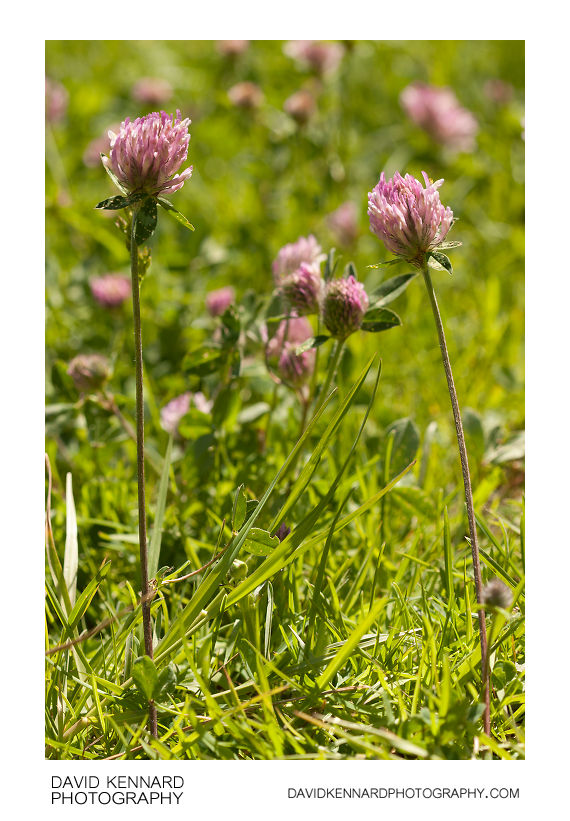Red Clover (Trifolium pratense)

Description
- Title:
- Red Clover (Trifolium pratense)
- Caption / Description:
-
Trifolium pratense (Red Clover) is a species of clover, native to Europe, western Asia and northwest Africa, but planted and naturalised in many other regions.
It is an herbaceous, short lived perennial plant, variable in size, growing to 20–80 cm tall. The leaves are alternate, trifoliate (with three leaflets), each leaflet 15–30 mm long and 8–15 mm broad, green with a characteristic pale crescent in the outer half of the leaf; the petiole is 1–4 cm long, with two basal stipules. The flowers are dark pink with a paler base, 12–15 mm long, produced in a dense inflorescence.
It is widely grown as a fodder crop, valued for its nitrogen fixation which increases soil fertility. For these reasons it is used as a green manure crop. Several Cultivar Groups have been selected for agricultural use, mostly derived from var. sativum. It has become naturalised in many temperate areas, including the Americas and Australasia as an escape from cultivation.
Red Clover contains isoflavones (estrogen-like compounds) which can mimic the effect of endogenous estrogen. The use of red clover to relieve menopausal symptoms has been shown to be ineffective, but safe. Red clover contains calcium and magnesium which can relax the nervous system and improve fertility. Traditionally, Red Clover has been administered to help restore irregular menses and to balance the acid-alkaline level of the vagina to promote conception.
The isoflavones (like irilone and pratensein) from red clover have been used to treat the symptoms of menopause. It has also been reported that red clover has been used for a variety of medicinal purposes, such as bronchitis, burns, cancers, ulcers, sedation, asthma, and syphilis.
It is an ingredient in eight-herb essiac tea.
Description taken from Wikipedia: http://en.wikipedia.org/wiki/Trifolium_pratense
- Tags / Keywords:
-
- Biota
- Life
- Vitae
- Eukaryota
- Plantae
- Plants
- Magnoliophyta
- Flowering Plants
- Angiosperms
- Magnoliopsida
- Dicotyledons
- Fabales
- Fabaceae
- Bean
- Purple clover
- Trifolium
- Trefoil
- Trifolium pratense
- Red Clover
Admin
- Date Original Photo Taken:
- Original File Name:
- _MG_0043.CR2
- Event:
- Rating:
- ☆
- Date this image added/last updated on website:
- Original File Dimensions:
- 2848px x 4272px
- File Type:
- JPEG
- Color Mode:
- RGB
- Original Image Color Profile:
- Adobe RGB (1998)
Location
- Location Created:
-
- Sublocation:
- City:
- Market Harborough
- Province/State:
- Leicestershire
- Country:
- United Kingdom
- World Region:
- Europe
- Geo-location:
Rights
- Copyright Status:
- Copyrighted
- Licensing Status:
- Rights Managed
- Available for Editorial Use:
- Yes
- Available for Commercial Use:
- Yes
- Copyright Notice:
- © 2010 Dave Kennard
Camera Data
- Date Digital Resource was created:
- Shutter speed:
- 1⁄200 s
- Aperture:
- f/5.6
- Camera Model:
- Canon EOS 450D
- ISO:
- 100
- Exposure Compensation:
- 0
- Focal Length:
- 100mm
- Focal Length (35mm equiv.):
- Metering Mode:
- Multi-segment
- Flash:
- Off, Did not fire
- Exposure Mode:
- Manual
- White Balance:
- Manual
- Light Source:
- Exposure Program:
- Manual
Additional shooting metadata
- Lens:
- Canon EF 100mm F2.8 Macro USM
- Filters used:
- Additional Optics used:
- Setup:
- Handheld
Post Processing
- Image Modified:
- Software used:
-
- Adobe Camera RAW
- Post Processing:
